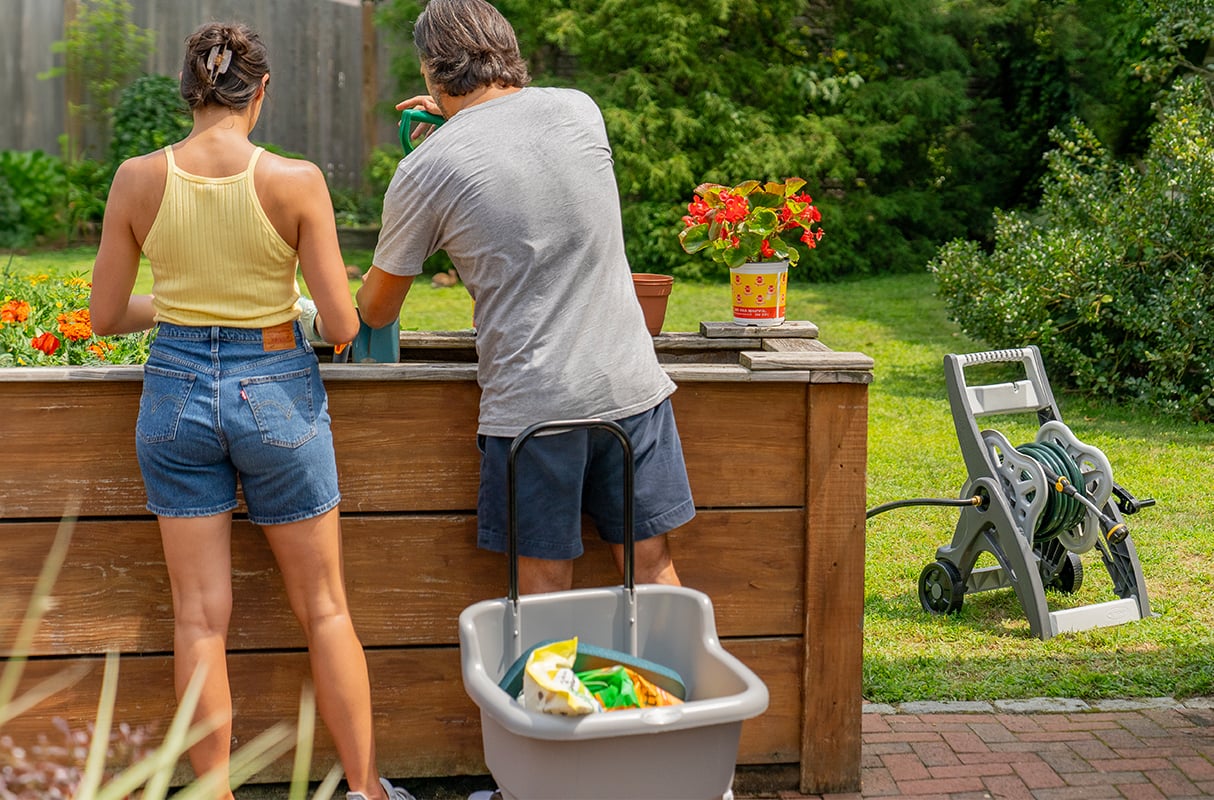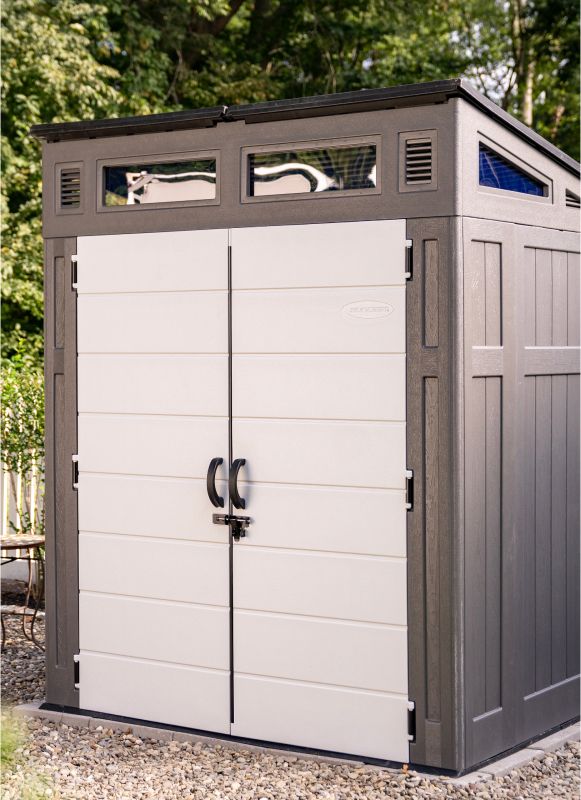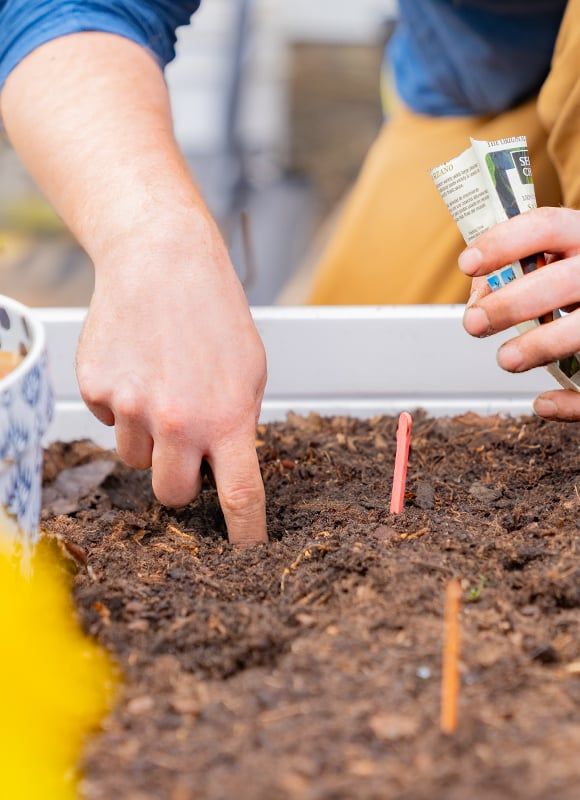Storage Shed Buying Guide
The Differences Between Pre-Built and DIY Sheds


A sturdy, reliable storage shed provides invaluable organizational opportunities all year long, but finding the right one to fit your space (and budget) can be a challenge! The good news? You have plenty of options to choose from.
There are so many things to consider, including size, cost, capacity, construction material, and even style and color. But perhaps the most important question is whether you should buy a fully constructed shed or a shed you can assemble yourself in your spare time.
Let’s break down some of the pros and cons of pre-built and DIY sheds so you can confidently choose the best option for your home, your family, and yourself.
Jump to a Topic:
The search for the perfect shed begins right in your own backyard. Take note of any obstructions or features in your yard that may affect placement (such as trees, fences, or utilities). Also consider proximity to pathways, driveways, or gates to ensure convenient entry and exit. Think about the visual impact of the shed on your property as well—some people prefer placing sheds in less conspicuous areas, while others integrate them into the landscaping or select a style that neatly complements the architecture of their home.
Select a flat, level space and watch it closely during and after a rainstorm to make sure water doesn’t pool in the area. Proper drainage is critical to maximize the lifespan of your shed!




Quick Tips:
- Choose a flat, level place for your shed that’s easy to access and free of obstructions
- Consider the visual impact of the shed on your property
- Make sure rainwater doesn’t pool around the area
It can be difficult to determine exactly how much storage space you need when shed shopping. Start by taking inventory of what you plan to put in the shed, noting the dimensions of larger items such as lawnmowers, snowblowers, bicycles, and furniture. Keep in mind that it's often more cost-effective to invest in a larger shed than you would need today than it is to upgrade later when you run out of space! While you’ve got your tape measure handy, take a few minutes to record the length, width, and height of the surrounding area as well to get a sense of what size shed will fit comfortably within the measured space.
Pre-built sheds generally fall on the larger end of the spectrum, which is useful if you have a big backyard and serious storage needs. DIY shed options are plentiful in this size range as well but are also available in smaller configurations to fit virtually any space (garden, deck, patio—the possibilities are endless!).


Consider a slim, small-footprint vertical shed if you need to save square footage but still want easy access to long-handled tools, sports equipment, or gardening gear. Or opt for a stout horizontal shed to stow grab-and-go essentials like your bike or mower. Horizontal and vertical DIY sheds both offer incredible versatility, and their small size means they’re much easier to assemble than larger storage solutions.
Lastly, we always recommend that you check (and double-check!) local building codes, homeowners’ association rules, and zoning regulations to determine if a permit is required for shed construction. Regulations may vary depending on the size, location, and intended use of your shed, so it’s essential to research the specific requirements for your home before making a major purchase.


Quick Tips:
- Invest in a larger shed than you need today
- Measure your space to determine maximum shed size
- Consider DIY vertical and horizontal sheds for smaller spaces
- Be sure to check local building codes and other regulations before buying a shed
A shed isn’t a small purchase—and sticker price doesn’t tell the whole story. A pre-built shed is often the more expensive option, as construction and installation costs are built into the price. This extra expense sometimes includes the ability to participate in the design process, enabling you to tailor every aspect of the shed to your liking—no other option offers you that level of control over the final product.
DIY sheds, on the other hand, cost dramatically less on average. The trade-off, of course, is that you’re on the hook for setting everything up! The good news is that the term “do it yourself” can be misleading. There are plenty of affordable and attractive shed options out there that don’t require sourcing lumber and building everything entirely from scratch.


DIY shed kits like those designed by Suncast include all the walls, roof panels, and parts you’ll need to fully construct your shed—and even include step-by-step directions to simplify the process. Additionally, Suncast offers handy how-to videos for many of our most popular shed models to make assembly even easier. In fact, most Suncast sheds can be built in a matter of hours over the course of a typical weekend.
Still, it’s important to assess your own comfort and skill level as well as the size of the unit and complexity of the instructions before committing to a DIY approach. If you do choose to DIY, make sure you have all the necessary equipment on hand before getting started. (Many DIY shed kits require just a few simple tools you probably already own, like a screwdriver and hammer.) And don’t be afraid to call in the pros if you need help; even after labor costs, a DIY shed is still often the least-expensive option.




Quick Tips:
- Pre-built sheds are usually more expensive
- DIY shed kits can be built in a weekend with a few simple tools


When thinking about the long-term impact of purchasing a shed, don’t forget to factor in the value of your time! A pre-built shed can take weeks or even months to arrive at the finish line—significantly longer than if you decide to take the project on yourself. Minimally, the process demands coordinating with the manufacturer or retailer as well as potentially one or more contractors or installers; this often means you’re stuck waiting on someone else’s schedule in order for your new shed to be built, delivered, and installed.
Regardless of what type of shed you choose, creating a proper base is essential for the longevity and stability of the structure. Pre-built sheds generally require a gravel base, which in itself can be a costly and time-consuming undertaking. Once this foundation is in place, the pre-built shed will be delivered (sometimes days or weeks later) using heavy machinery that can cause damage to your yard. The time it takes for your grass to regrow and for other restoration work to be completed is yet another factor to consider.


Some medium and large DIY sheds require a foundation as well, though the solutions are generally more affordable. Low-cost lumber and plastic pier blocks are an easy way create a level platform—and both should be readily available at your local hardware store. Better yet, they can be installed without the need to have heavy machinery roll across your beautiful lawn.


Quick Tips:
- Pre-built sheds can take months to arrive
- Pre-built sheds may require heavy machinery that can damage your lawn
- More-affordable and less-disruptive foundation options exist for DIY sheds
There’s another hidden cost that comes with purchasing a shed—the value of the items inside! Safeguard your investment by picking a building material that is sturdy and reliable all year round and will last for years to come. Here are a few of the most popular options:


Wood
Many love the look of natural wood, which offers shed owners additional customization options because it can be painted or finished. Keep in mind, however, that wood is often the most expensive choice and requires regular upkeep. Wood can also be easily splintered or damaged and is prone to rot over time.


Metal
Metal sheds are a popular choice, as they are generally lightweight, easy to assemble, and affordable when compared to wood alternatives. However, metal often rusts over long periods of time outdoors and can be easily dented or bent when removing and returning heavy tools or equipment.


Resin
Suncast’s DIY shed kits include resin walls and metal framing components, which together offer the best of both worlds without many of the potential drawbacks. Resin is a high-density synthetic compound that is lightweight, durable, and economical, meaning it is structurally superior to wood and perfect for long-term outdoor use. From summer thunderstorms to wicked winter blizzards, resin is reliable all year round and cleanup couldn’t be simpler—just grab a hose and some mild soap and give it a good scrub!
Resin stands up exceptionally well to heavy daily usage and even pests such as termites. It’s also resistant to mold and mildew and has UV protective properties, so it generally lasts a lot longer than wood-based sheds. In short, resin is a low-cost material capable of protecting your expensive investments from external hazards and adverse weather events—even a falling tree!


Quick Tips:
- Wood is attractive and customizable but usually the most expensive option
- Metal is lightweight and easy to assemble but often rusts and can be easily dented or bent
- Resin offers the best of both worlds without many of the potential drawbacks
Whether you pick your dream shed out of a catalog or choose an affordable and durable DIY option, you now have a framework to help you see the project through to completion. There’s nothing quite like the feeling of satisfaction that comes with seeing your hard work on full display in your backyard—doubly so if you built it with your own two hands. Now you can begin filling your new shed with purpose by safely stowing away all your essential tools, gear, equipment, outdoor furniture, and more!
















